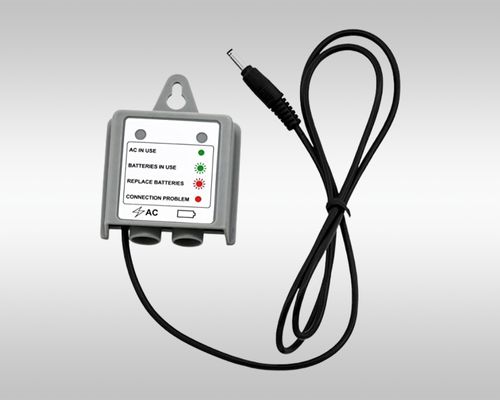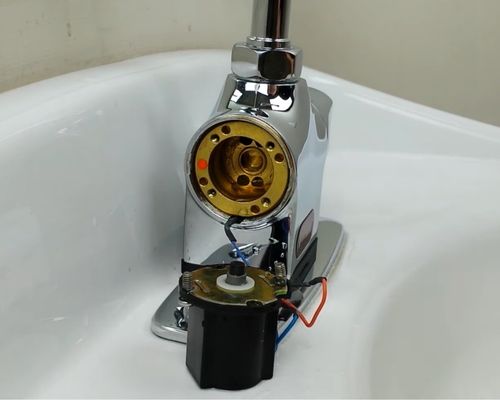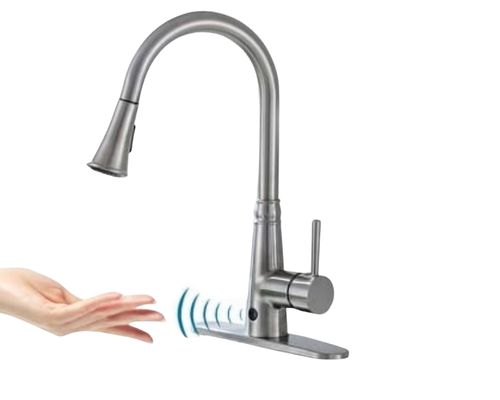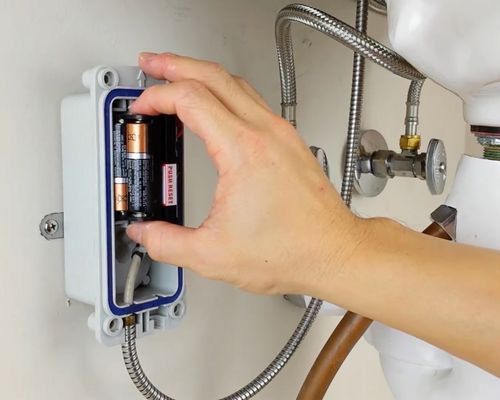Touchless Faucet Turns On By Itself! [Solved]
As the name implies, you do not require to touch the touchless faucet to operate. Motion sensor faucets, automatic faucets, touch-free faucets, and touchless taps are other names for touchless faucets.
Automatic or touchless faucets are mainly popular in public places such as hospitals, restaurants, or airports. Not only in the public bathroom but this faucet also uses frequently in homes.
Although touchless faucet comes with a lot of advantage, sometimes they occur some issue. Occasionally it turns on by itself.
I’ll discuss the causes of a touchless faucet turning on automatically in this article.
The Causes of Touchless Faucets that Automatically Turn on
Many reasons cause a touchless faucet to turn on by itself. The main reason for this problem issue is the sensor.
If your touchless faucet has a control box, then the issue may occur because of the battery issue. Below I have described some reasons for turning on a touchless faucet automatically.
1. Dirty Sensor
Sometimes the sensors get dirty. Users wash their hands and dishes with dirty hands, which causes the sensor to become dirty.
Occasionally, debris covers the sensor, causing turning on the faucet to automatically. If your faucet’s sensor gets dirty you need to clean it.
Dip a clean cloth in soapy water and wipe the sensor.
2. Unintentional Reflection
If the sensor detects an unintentional reflection, it may turn on the faucet. The sensor accidentally detects when an object reflects in the sensor zone.
Doorknobs, plants, or other decorative items can activate the sensor of the faucet. As a result, the sensor instructs the faucet to turn on.
So, when your touchless faucet turns on automatically, ensure there are no objects near the faucet’s sensor.
3. The Issue With the Power Source
If your touchless faucet has a control box, the power source might cause the automatic faucet to turn. Some cables are connected to the control and battery boxes beneath the basin.
If your power cord becomes loose, the faucet could start emitting erratic signals. Your batteries won’t send signals correctly if they are low or fastened erratically.

So, Check the cable connecter and tighten them if needed.
On the other hand, a weak battery can also send an erratic signal. In this case, you need to replace the batteries.
4. Worn Rubber Washer
Whenever the faucet attempts to turn off, the job of the rubber washer is to seal the water. The washer presses tightly against the valve seat.
As a result, the water prevents the water from flowing. The washer won’t be able to stop the water from flowing if it becomes worn.
So, if your faucet turns on automatically then check the washer. You need to replace the washer if the washer is worn.
5. Issue with Solenoid
The touchless faucet sensor commands the solenoid valve to shut off and on the water flow. When an object comes near the sensor, it orders the solenoid to turn on the water.
However, the sensor will only instruct the solenoid valve to stop the water flow after a certain amount of time has passed when the object is no longer present.
So, a faulty solenoid in the control box can be a reason for turning the faucet automatically. In this instance, the solenoid needs to be changed.

You can get a replacement solenoid from the faucet manufacturer if your product is under warranty.
If your touchless faucet has no control box then the battery pack and solenoid of the faucet are inside the spout. At this point, you need to remove the body of the spout to access the battery pack and solenoid.
What Should I Do If Your Automatic Faucet Turns On By Itself?
The automatic faucet has a sensor that opens the touchless faucet valve. An automatic faucet could turn on by itself due to a dirty sensor.
Therefore, inspect the sensor on your automatic faucet, and clean it if you find any debris there. Opening the valve the sensor allows water to flow when the user put their hand under the faucet.

Besides, if the sensor no longer detects a hand, it closes its valves after a few seconds.
However, occasionally the touchless faucet turns on automatically. The reasons for this problem are defective solenoid and a dirty sensor.
The steps you need to take to fix this issue when your automatic faucet turns on automatically are given below –
Clean the Sensor
An automatic faucet could turn on by itself due to a dirty sensor. Therefore, inspect the sensor on your automatic faucet, and clean it if you find any debris there.
Take a clean cloth and soak it in the water. Next, clean the sensor.
Change the Batteries
Low or dead batteries are the reason for turning on the faucet automatically. If you notice a red light flashing on the faucet’s sensor, the batteries are running low.
However, when the batteries are dead, the red light will remain on.
You should change the batteries if it is low or dead if to stop your faucet from turning on automatically.

You can change the battery by following some easy steps.
- First, remove the screw from the faucet’s body with an Allen key.
- Remove the temperature level on your faucet if it has one.
- Then take out the upper body cover of your faucet.
- Now remove the batteries and install a new one.
- Next, reinstall the upper body of the faucet and screw.
Replace the Solenoid
If your battery is not faulty, you must replace the solenoid. Because the solenoid valve receives commands from the sensor to turn on and off the sensor.
A defective solenoid will be unable to maintain the commands. As a result, the faucet started on its own. The process of replacing the solenoid is given below.
- Turn off the water supply valve.
- Then remove the upper body of the faucet by unscrewing the screw from it.
- Next, disconnect the wire from the solenoid.
- Now use a wrench to remove the solenoid.
- Finally, install the new solenoid and tighten it with the wrench.
Can You Disable Touchless Faucet?
Yes, you can disable a touchless faucet. To disable a touchless faucet, hold your hand over the sensor for ten seconds.
After ten seconds, when a blue light blinks then, the sensor of the touchless faucet will be disabled. Most of the Moen touchless faucets can disable through this process.
Moreover, you can disable the touchless faucet by removing the batteries or solenoid valve. Some faucet bands like Delta or Kohler require removing batteries or a solenoid valve to disable a touchless faucet.
Is the Touchless Faucet Malfunction Caused by the Hot and Cold Sides of the Faucet?
Is the touchless faucet malfunction caused by the hot and cold sides of the faucet? The hot and cold faucet mystery remains unsolved. While it’s possible that temperature fluctuations affect the sensor’s performance, other factors like sensor calibration, power supply issues, or even faulty components could also contribute to the malfunction. Professional assistance may be needed to uncover the true cause behind the touchless faucet glitch.
Why Kitchen Faucet Sprayer Is Not Shutting off?
The touchless kitchen faucet comes in different designs. Such as pull-down or pull-out kitchen faucets with single or double handles.
Some kitchen faucets have spray and stream modes. Besides, some faucets did not have this feature. So, in this case, you can use a kitchen faucet sprayer.
But sometimes the kitchen faucet sprayer does not shut down. The reasons for this cause are a faulty diverter or clogged screens.
Final Words
The turning on of a touchless faucet automatically is an annoying thing for the user. It also wastes a lot of water.
It is your responsibility to fix your faucet as soon as possible if it begins to turn on its own. So when you notice the touchless faucet automatically turning on, the first thing you should do is clean the sensor and make sure no objects are near it.
Then examine the power supply, rubber washer, and solenoid. Then, replace the batteries, washer, or solenoid, depending on the situation.

